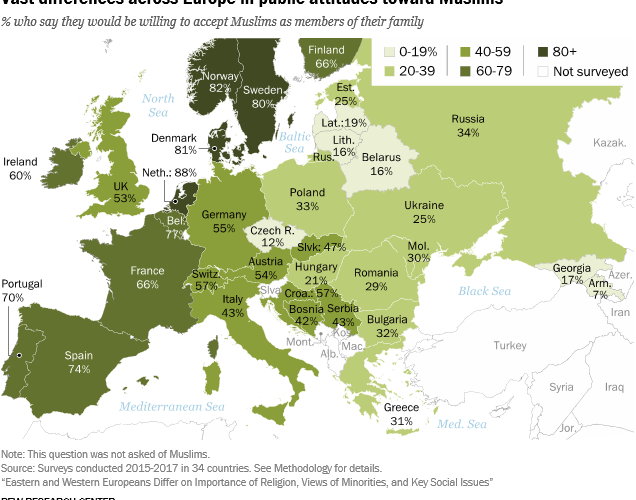The origin of Islam was at Mecca in the Arabian region during the 7th century. From the 8th century till the 13th century, Islam was widespread towards the Arabian Peninsula, covering the present-day areas of Qatar, United Arab Emirates, Kuwait, Omen, Saudi Arabia, and Yemen. Slowly after the emergence, Islam started to spread to the regions of transcontinental countries like Kazakhstan, Turkey, and Azerbaijan. The prominent and holy cities of Islam include Mecca, Medina, and Jerusalem.
The fall of the Roman Empire resulted in significant fragmentation of the lands. The spread of Islam was initially a religious and spiritual movement. But after the acquirement of the regions of Persia and the Eastern Roman empire significantly strengthened them, which aided in the further invasions and expansions.
Islam in Southern Europe

Southern Europe was also enlightened with Islam by 711 AD by the Muslims. The end of the Prophet’s era saw various emergences of groups and caliphates, emirates, and sultanates. Mohammed successfully united all the Muslim invasion of Europe tribes based in Arabia under a single empire with his immense effort. The immediate succession of Mohammed after his demise in 632 AD was succeeded by the Rashidun Caliph, Akbr Ali.
Caliph was a title given to a political, religious, and spiritual leader who followed Islam and preached the words of the prophet. Rashidun caliphate reigned from 632 AD till 661 AD. The Rashidun caliphate was followed by the Umayyad caliphate from 661 AD to 750 AD. Under the rule of the Umayyad caliphate, the Muslim expansion to Europe was very much prevalent.
By 711 AD, the Umayyad conquered the majority of the Iberian peninsula. The Iberian Peninsula includes Spain, Portugal, and Andorra. The Iberian Peninsula and regions of Hispania were under the Visigoth King Roderic. Umayyad general Tariq ibn Ziyad landed in the city of Ghibbratar across the Atlantic Ocean. Umayyad general Tariq ibn Ziyad along with the Berbers, overthrew the Visigoth King Roderic at the battle of Guadelete
. The Umayyad caliphate, with the combined forces of Umayyad general Tariq ibn Ziyad and Wali Musa ibn Nusayr, the Umayyad caliphate took control of the majority of the Iberian peninsula within a few years of expansion. The conquering of Hispania and the surrounding regions was the key to the entry of the Muslims invasion to the European countries. Al Andalus was specially referred to as the Muslim territory of the Iberian peninsula. The whole campaign of Umayyad general Tariq ibn Ziyad was successful and fulfilled. BY the 11th century, the number of Muslims invasion in this region raised to 5.5 million.
The Reconquista of the Christians was also predominant during the same time. The Muslim emir Aghlabids conquered Sicily by various expeditions throughout the 9th century. By 831 AD, the Emirates of Sicily was established and was flourishing with the Muslim culture till 1091 AD.
The Franks and the Muslims

The Frankish kingdom of dukedoms ruled the current regions of France and parts of Germany. The internal affairs and problems related to the heir led to various civil wars among the Franks. The Muslims of Al Andalus utilized this opportunity to invasion the Franks. Aquitaine was a southern city in the Frankish Kingdom. In the year 721 AD, tried to enter Aquitaine via the Pyrenees mountain range.
This invasion was a failure as the Muslim troops were heavily defeated by the Frankish king, Duke Eudo. During this period, the Muslims also invaded and looted many cities, vandalized churches monasteries, and even completely burned down entire cities. By 732 AD, Abd ar-Rahman, an Iberian Governor, again tried to start the Muslim invasion of the Frankish empire by facing Duke Eudo in a battle. Abd ar-Rahman won the battle by defeating the Frankish king Duke Eudo.
They took over the city of Bordeaux and also destroyed the Poitiers Cathedral. Besides having previous issues, Duke Eudo joined forces with Charles, who was the son of King Pippin of the Frankish Kingdom. Charles was denied his succession after his father’s death due to various issues. Eventually, Charles took control of the Frankish empire from Plectrude. The combined forces of Charles, Duke Eudo, and other Franks joined together. The Muslim invaders faced Charles and his men at the Battle of Tours in 732 AD. The Battle of Tours marked the end of Abd ar-Rahman. The vast infantry of Charles defeated the Muslim cavalry, and therefore, the invasion were sent back to Iberia.
The End of the Umayyad Caliphate

The Muslims invasion now moved back to Iberia, and they never really invaded the region again. The Muslim raiders shifted their course to the northern areas of the Pyrenees mountain range. The Berbers, who were the troops under the Umayyad Caliphate eventually revolted against the caliphate which was the end of all the raids and invasion.
By 750 AD, the Umayyad rule faded and ended. The Umayyads lost their power to the Abbasidsand this led to the shift of the Umayyad prince Abd ar-Rahman from Damascus, the capital city to Iberia. Though the dynasties changed and rulers varied throughout the period, the Iberian peninsula and the parts ruled and dominated by the Islamic were continued to invasion and be ruled by the Muslim empires of various other empires.
- Rise of the Cordoba empire:
Abd ar-Rahman established the Emirate of Cordoba in 756 AD. The rise of the Emirate of Cordoba in 756 AD saw the rule of them in the region till 929 AD. Abd ar-Rahman worked in the unification of the al-Andalus region, which included Barcelona, Zaragoza, Pamplona, and Toledo. This unification took around twenty-five years.
Abd al-Rahman III, who ascended the throne in 912 AD, proclaimed himself as the Caliphate of Cordoba in the year 929 AD. The reign of the Caliphate of Cordoba was prevalent till 1031 AD. The fall of the Caliphate of Cordoba resulted in various civil wars among the taifas in the Iberian peninsula. The rule of the taifas was prevalent till the 12th century. The subsequent rise of the Kingdom of Granada in 1212 till their fall in 1492 covered the major presence of Islamic rulers in the Iberian peninsula.
Islam in Eastern Europe

The rise of the Turkish Ottoman Empire was between 1299 and 1453. Ottoman emerged from a small, Byzantine territory to a great dynasty. The Ottoman Empire of Turkey was constantly trying to invade Eastern European regions. There were multiple attempts of the invasion from the Ottoman Empire to invade and conquer Constantinople, which was the capital of the Byzantine empire. In 1453, Sultan Mehmed II of the Ottoman Empire successfully captured Constantinople.
Constantinople became the capital of the Ottoman empire and was now called Istanbul. Istanbul flourished with great socio-economic upliftments, artisans, and commercial trade. The Ottoman Empire ruler Mehmed focused on the political and military affairs of his empire. But still, conversions and anti-Christianism were very much prevalent in their Empire. Special concessions, waivers, and high military rankings were provided to people who converted to Islam, and high taxes were imposed on people who wanted religious freedom.
In the following years, the Ottomans tried the invasion and establish themselves in various European nations. Suleiman the Magnificent, who reigned between 1520 and 1566, captured parts of Serbia, Hungary after the Ottoman-Hungarian Wars. Suleiman waged a war on Vienna known as the Siege to Vienna in the year 1529. The initial Siege to Vienna was a failure. This was followed by another Siege of Guns in the year 1532, which also backfired on the Ottomans invasion.
Subsequently, Suleiman claimed the regions of Transylvania, Wallachia, Moldavia, parts of Caucasia, Western Armenia, parts of Kurdistan, and parts of Georgia. The Ottomans and the Habsburgs fought the Siege of Castelnuovo over a Spanish garrison which was a victory for the Ottomans. The common enemy of the Ottomans and the French were the Habsburgs. This created made the French and the Ottoman’s allies. The French monarch King Francis I and the Ottoman ruler, Suleiman together conquered a few Mediterranean regions. The struggle to conquer Vienna was seen throughout the years.
After a successful reign of more than 4 centuries, the Ottoman Empire started to decline due to increased European domination and the inability to manage the financial expenditures of the wars. During World War I, the Ottoman Empire supported Germany, which greatly impacted the Empire’s reputation. By the end of World War I, multiple territories of the Ottoman Empire were acquired by the European nations. The Ottoman Empire was given the nickname of “The Sickman of Europe.” In 1924 the Ottoman Empire completely declined and ended.
Conclusion
Apart from the various wars and battles fought by the Muslim invasion and their religious campaigns to spread Islam, major reformations, changes, and alterations were made by the Islamic rulers in architecture, arts, history, literature, political systems, languages, science, technology, and socio-economic ideologies. The influence and effect can still be very evident in many cultures and groups in European countries. The folklores, tales, and traditions are still being passed on to the younger generations.

